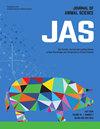151便携式近红外光谱法测定生长肉牛槽侧热铁牌号年龄的有效性
IF 2.9
2区 农林科学
Q1 AGRICULTURE, DAIRY & ANIMAL SCIENCE
引用次数: 0
摘要
尽管家畜执法专业人员认为热铁烙印是一种有效的威慑手段,但如果原始烙印被改变,动物身上的烧伤疤痕组织的年龄不同,那么有烙印的动物仍然可能被盗。将热铁烙印应用于生长中的牛,以确定便携式近红外光谱是否可以预测不同日期使用的热铁烙印的年龄。品牌应用于21安格斯交叉转向在大约3和7个月的年龄。品牌被随机分配给三个地点之一的每头牛(每个n = 7);臀部,肋骨和肩膀。第二次申请的品牌位置被提前了;例如,一只动物在3个月大时被烙在臀部,7个月大时被烙在肋骨上。光谱(400-2500 nm)用ASD Field Spec Pro®从每只动物的烙印和非烙印皮肤的3个重复中收集,每次烙印应用后约2小时。在7个月时,收集了新(NEW)和旧(OLD)品牌的光谱。分别通过主成分聚类分析和多元偏最小二乘回归程序完成品牌年龄组的识别和品牌年龄(0.5和145-d)的预测。通过卡方程序确定群体识别比例的差异。基于多重决定系数(RSQ)和完全留一交叉验证(SECV)的均方根误差对预测校准性能进行了评价。通过方差分析确定组间品牌年龄的差异。P <;0.05. 无监督聚类分析烙印皮肤产生的光谱(P <;0.01),包括:a) 80% NEW和20% OLD品牌皮肤,b) 2% NEW和98% OLD品牌皮肤。品牌年龄预测校正结果RSQ = 0.92, SECV = 20.9天。平均预测品牌年龄(P <;0.01), 0.5 d和145 d组分别为5.4±2.6和140.1±2.2 d。0.5 d组标准差为19.6天,145 d组标准差为16.7天。与其他研究类似,便携式近红外光谱能够准确区分在同一动物身上两个不同日期使用的品牌。在这些7个月大的阉牛中,品牌年龄组的识别成功率约为90%,因此,可以用来确定给定的品牌是否已经改变。对品牌年龄的预测也很成功,但标准偏差表明,如果需要确定品牌申请的实际日期,这种技术目前可能不足以准确地用于法律应用。因此,需要在不同动物类别和野外环境中进一步评估这种技术。本文章由计算机程序翻译,如有差异,请以英文原文为准。
151 Effectiveness of portable near infrared spectroscopy for chute-side determination of hot-iron brand age in growing beef cattle
Although livestock law enforcement professionals consider hot-iron branding as an effective deterrent, theft of branded animals may still occur if the original brand is altered, thus creating different ages of burn scar tissue on an animal. Hot-iron brands were applied to growing beef steers to determine if portable near infrared spectroscopy could predict the age of hot-iron brands applied on different dates. Brands were applied to 21 Angus cross steers at approximately 3 and 7 months-of-age. Brands were randomly assigned to each steer in one of three locations (n = 7 each); hip, rib, and shoulder. Brand location was rotated forward for the second application; e.g. an animal branded on the hip at 3 months was branded on the rib at 7 months. Spectra (400-2500 nm) were collected with an ASD Field Spec Pro® from 3 replicates of branded and non-branded skin on each animal, approximately 2 hours after each brand application. At 7 months, spectra were collected from both the recent (NEW) and former (OLD) brands. Identification of brand age groups and prediction of brand age (0.5 and 145-d) were accomplished via principal component cluster analysis and multiple partial least squares regression procedures, respectively. Differences in proportions of group identification were determined via chi square procedures. Predictive calibration performance was evaluated based on multiple coefficient of determination (RSQ), and the root mean square error of a full leave-one-out cross-validation (SECV). Difference in brand age between groups was determined via analysis of variance. Significance was determined at P < 0.05. Unsupervised cluster analysis on spectra from branded skin produced groups (P < 0.01) consisting of: a) 80% NEW and 20% OLD branded skin, and, b) 2 % NEW and 98% OLD branded skin. The brand age prediction calibration resulted in an RSQ = 0.92 and SECV = 20.9 days. Mean predicted brand age (P < 0.01) was 5.4 ± 2.6 and 140.1 ± 2.2 days for the 0.5-d and 145-d groups respectively. The standard deviation was 19.6 days for the 0.5-d group and 16.7 days for the 145-d group. Similar to other studies, portable near infrared spectroscopy was able to accurately discriminate between brands applied at two different dates on the same animal. Identification of brand age group was approximately 90% successful in these 7-month-old steers and thus, could be used to determine if a given brand has been altered. Prediction of brand age was also successful, but the standard deviation indicates that this technique may not currently be sufficiently accurate for legal applications if establishment of an actual date of brand application is called for. Further evaluation of this technique in diverse animal classes and field environments is thus called for.
求助全文
通过发布文献求助,成功后即可免费获取论文全文。
去求助
来源期刊

Journal of animal science
农林科学-奶制品与动物科学
CiteScore
4.80
自引率
12.10%
发文量
1589
审稿时长
3 months
期刊介绍:
The Journal of Animal Science (JAS) is the premier journal for animal science and serves as the leading source of new knowledge and perspective in this area. JAS publishes more than 500 fully reviewed research articles, invited reviews, technical notes, and letters to the editor each year.
Articles published in JAS encompass a broad range of research topics in animal production and fundamental aspects of genetics, nutrition, physiology, and preparation and utilization of animal products. Articles typically report research with beef cattle, companion animals, goats, horses, pigs, and sheep; however, studies involving other farm animals, aquatic and wildlife species, and laboratory animal species that address fundamental questions related to livestock and companion animal biology will be considered for publication.
 求助内容:
求助内容: 应助结果提醒方式:
应助结果提醒方式:


